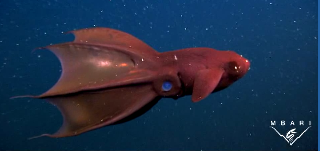Vampyroteuthis Infernalis The Vampire squid from Hell is so Exceptional: Biologists come from deal a harsh blow to the reputation of the vampire squid, small cephalopods to halfway between Octopus and Squid: far is feast of live prey, the animal is only a scavenger of the depths to scrounge crumbs corpses. > average only 13 cm in length, the cephalopod lives in temperate and tropical oceans, by 600 to 900 metres deep, where he spotted any movement with his big Googly eyes (2.5 centimeters).

Where legend counterpart is able to disappear in a cloud of smoke, the vampire squid, itself, is camouflaged in early of a bio-luminescence blue night.
But unlike Dracula, Nosferatu and their cousins, the sea vampire plant never his fangs into a living prey, provide two California researchers, who have went through thirty years of data collected on the little monster.
The analysis of the stomach and the animal feces is formal: it feeds on corpses and fragments of larvae, crustaceans, and zooplankton that flow slowly at the bottom of the oceans.
Hendrik Joving and Bruce Robison of the Monterey Bay (MBARI) Aquarium Research Institute, also lifted the mystery that hung over the incredible hangover of the beast: a black umbrella kind which membrane connects the eight arms of the vampire, anti-elephant on their inner face of rows of spines and topped with suction cups.
Between these arms, two pockets contain long retractile filaments that resemble those of a squid. Long considered to be sensory appendages to detect prey and predators, it is in fact tools enabling the vampire to take fragments of corpses to his mouth, indicate the two researchers in the British journal Proceedings of the Royal Society B.
With a sticky mucus secreted by the appendages, the vampire agglomerate these crumbs of food to form a small ball, then routed to its beak thorns covering his arms.
“The feeding behavior of the Vampyroteuthis not resembles that of no other cephalopod”, summarizes the study.
It indicates “a unique adaptation, which allows these animals spend most of their lives at depths where the oxygen is very low, but where there is very little predators and food traditional cephalopods”, say researchers. via AFP




